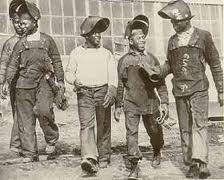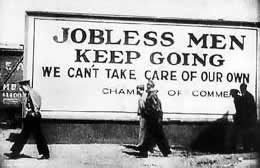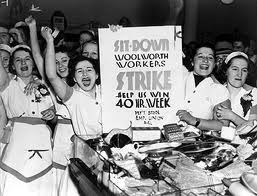Unions initially argued for shorter hours on the grounds that long hours were unhealthy, and because of fatigue, unsafe. Once the eight hour day began to be established they then argued for a five day week as a way of ensuring that jobs were maintained. One  American labour leader, Samuel Gompers (pictured), stated that “As long as there is one man [sic] who seeks employment and cannot find it, the hours of work are too long.” Shorter hours also increased wages because more overtime would be paid.
American labour leader, Samuel Gompers (pictured), stated that “As long as there is one man [sic] who seeks employment and cannot find it, the hours of work are too long.” Shorter hours also increased wages because more overtime would be paid.
Others, including unions in the US, Britain and France, demanded higher wages and more free time as their share of raising productivity and as compensation for the degrading conditions of work. Nevertheless trade unions still conceived of work as the central organising principle of the worker’s life and the most important aspect of their lives.
Various attempts at shortening the work week by striking unions had mixed success after the first world war in the US and Britain. Workers in the clothing industry in the US, which employed a high proportion of Jewish workers whose Sabbath fell on the Saturday, generally won a five-day week during the 1920s.  However, American steel workers continued to work 12 hour shifts and the coal miners won wage rises rather than a shorter day. British coal miners actually saw their working day increase. As real wages fell in Britain and France during the 20s the dream of leisure time faded.
However, American steel workers continued to work 12 hour shifts and the coal miners won wage rises rather than a shorter day. British coal miners actually saw their working day increase. As real wages fell in Britain and France during the 20s the dream of leisure time faded.
US unions fell in with the consumption solution to overproduction in the late 1920s and concentrated on fighting for higher wages. Union leaders promoted increased production and economic growth as a way of increasing wages.
In Europe the paid vacation was an employer preferred alternative to the shorter working week. Wages remained lower than in the US and purchasing power did not increase as fast. Although mass consumption came much later to Britain and Europe, Ford’s theories that higher wages and shorter weeks would avoid market saturation, found agreement amongst industrial engineers there.
 It was not till the Great Depression of the 1930s that the unions again fought for a shorter working week as a solution to unemployment.
It was not till the Great Depression of the 1930s that the unions again fought for a shorter working week as a solution to unemployment.
Those workers whose work was irregular wanted long hours when they did work to make up for when they didn’t. Gary Cross argues in Time and Money: The Making of Consumer Culture, that it wasn’t so much consumer culture as “the whip of job and wage insecurity and the absence of a viable alternative” that drove workers to prefer higher wages over increased leisure time. “Depression diminished the value of leisure time for wage-earners” whilst increasing the value of an income.
The topic of shorter working hours as a solution to unemployment again took centre stage as increased consumption seemed like an unlikely solution when so many people couldn’t even afford life’s necessities. US unions argued for a 30 hour week and some large firms such as Kellogg’s, Sears Roebuck, General Motors and Standard Oil, in fact introduced it voluntarily at some of their plants.
 Legislation in the US during the Depression set the standard working week at 40 hours over five days. Nevertheless long hours through the use of overtime continued. A plan to introduce a thirty hour week in order to spread employment was passed in the US Senate but business interests were outraged, “barraging the Roosevelt administration with pressure and threats”.
Legislation in the US during the Depression set the standard working week at 40 hours over five days. Nevertheless long hours through the use of overtime continued. A plan to introduce a thirty hour week in order to spread employment was passed in the US Senate but business interests were outraged, “barraging the Roosevelt administration with pressure and threats”.
Businessmen, even those who had reduced work hours voluntarily, were afraid that such legislation might institute the 30 hour week as a permanent feature. For them recovery from the depression entailed a return to business as usual with long working hours and increased consumption. The President was forced to “abandoned his support for the thirty hour week” and it was never introduced. In its place, Roosevelt introduced work creation schemes.
After the second world war the idea of solving unemployment by reducing working hours disappeared from mainstream thinking. During the war a demand for consumer goods had built up and following it workers tended to prefer wage rises to shorter hours.
The promise of full-employment assuaged fears that long work hours might create unemployment. Leisure became consumer-oriented, revolving round the home with its entertaining and convenience goods and the vacation where workers could enjoy living in luxury for a short time. As Cross noted: “The identification of leisure with consumption won many to hard and steady work in disagreeable jobs.”
The issue of working fewer hours instead of getting extra wages was seldom discussed after the war and was off the agenda for several decades, a non-issue, despite its high priority before the 1940s. As a result working hours stabilised at 40 per week in the US until the 1970s when they started to increase again.
Juliet Schor noted in her book The Overworked American that productivity in the US has been increasing steadily since the 1940s: “we could now produce our 1948 standard of living (measured in terms of marketed goods and services) in less than half the time it took in that year. We could actually have chosen the four-hour day. Or a working year of six months....” Instead workers work more hours now than in 1948 and consume more than twice as much.